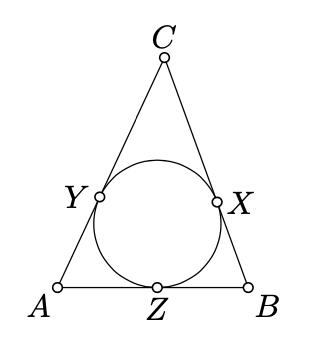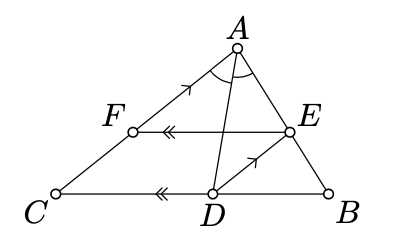8.7: More exercises
- Page ID
- 57681
Assume that an angle bisector of a nondegenerate triangle bisects the opposite side. Show that the triangle is isosceles.
- Hint
-
Apply Lemma 8.4.1. Also see the solution of Exercise 11.1.1.
Assume that at one vertex of a nondegenerate triangle the bisector coincides with the altitude. Show that the triangle is isosceles.
- Hint
-
Apply ASA to the two triangles that the bisector cuts from the original triangle.
Assume sides \([BC]\), \([CA]\), and \([AB]\) of \(\triangle ABC\) are tangent to the incircle at \(X\), \(Y\), and \(Z\) respectively. Show that
\(AY = AZ = \dfrac{1}{2} \cdot (AB + AC - BC).\)

By the definition, the vertexes of orthic triangle are the base points of the altitudes of the given triangle.
- Hint
-
Let \(I\) be the incenter. By SAS, we get that \(\triangle AIZ \cong \triangle AIY\). Therefore, \(AY = AZ\). The same way we get that \(BX = BZ\) and \(CX = CY\). Hence the result.
Prove that the orthocenter of an acute triangle coincides with the incenter of its orthic triangle.
What should be an analog of this statement for an obtuse triangle?
- Hint
-
Let \(\triangle ABC\) be the given acute triangle and \(\triangle A'B'C'\) be its orthic triangle. Note that \(\triangle AA'C \sim \triangle BB'C\). Use it to show that \(\triangle A'B'C \sim \triangle ABC\).
The same way we get that \(\triangle AB'C' \sim \triangle ABC\). It follows that \(\measuredangle A'B'C = \measuredangle AB'C'\). Conclude that \((BB')\) bisects \(\angle A'B'C'\).
If \(\triangle ABC\) is obtuse, then its orthocenter coincides with one of the excenters of \(\triangle ABC\); that is, the point of intersection of two external and one internal bisectors of \(\triangle ABC\).
Assume that the bisector at \(A\) of the triangle \(ABC\) intersects the side \([BC]\) at the point \(D\); the line thru \(D\) and parallel to \((CA)\) intersects \((AB)\) at the point \(E\); the line thru \(E\) and parallel to \((BC)\) intersects \((AC)\) at \(F\). Show that \(AE = FC\).

- Hint
-
Apply Theorem 4.3.1, Theorem 7.3.1 and Lemma 7.5.1.


